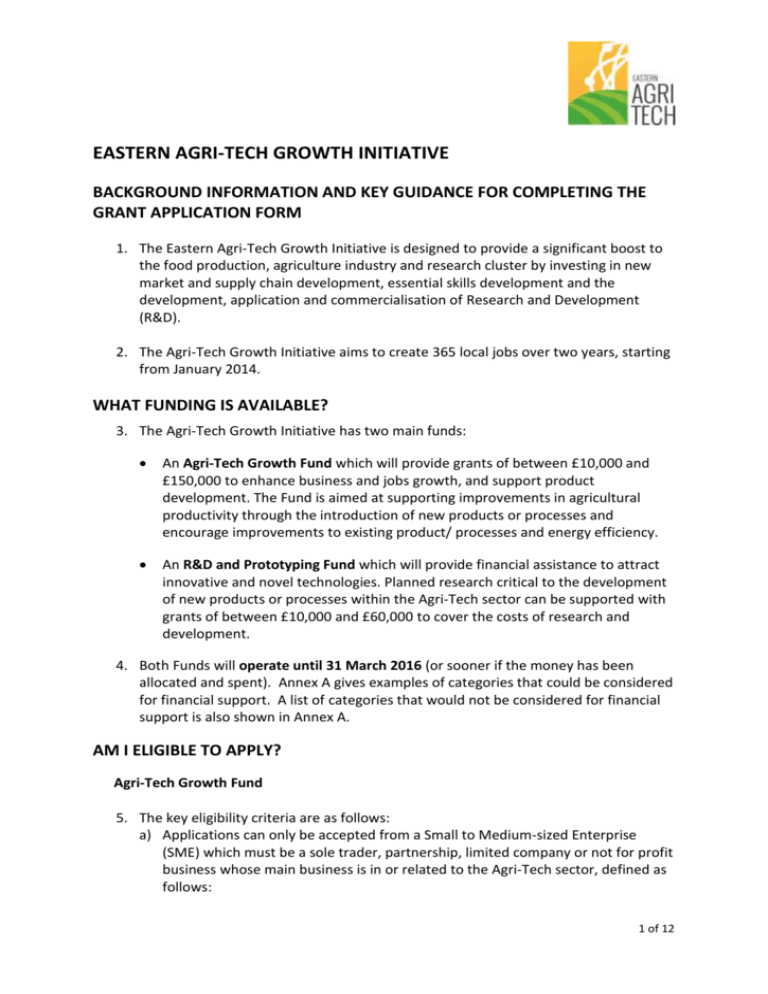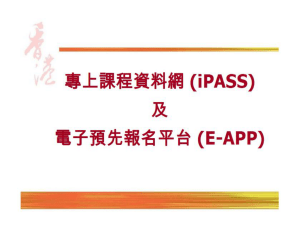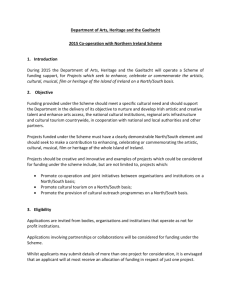eastern agri-tech growth initiative
advertisement

EASTERN AGRI-TECH GROWTH INITIATIVE BACKGROUND INFORMATION AND KEY GUIDANCE FOR COMPLETING THE GRANT APPLICATION FORM 1. The Eastern Agri-Tech Growth Initiative is designed to provide a significant boost to the food production, agriculture industry and research cluster by investing in new market and supply chain development, essential skills development and the development, application and commercialisation of Research and Development (R&D). 2. The Agri-Tech Growth Initiative aims to create 365 local jobs over two years, starting from January 2014. WHAT FUNDING IS AVAILABLE? 3. The Agri-Tech Growth Initiative has two main funds: An Agri-Tech Growth Fund which will provide grants of between £10,000 and £150,000 to enhance business and jobs growth, and support product development. The Fund is aimed at supporting improvements in agricultural productivity through the introduction of new products or processes and encourage improvements to existing product/ processes and energy efficiency. An R&D and Prototyping Fund which will provide financial assistance to attract innovative and novel technologies. Planned research critical to the development of new products or processes within the Agri-Tech sector can be supported with grants of between £10,000 and £60,000 to cover the costs of research and development. 4. Both Funds will operate until 31 March 2016 (or sooner if the money has been allocated and spent). Annex A gives examples of categories that could be considered for financial support. A list of categories that would not be considered for financial support is also shown in Annex A. AM I ELIGIBLE TO APPLY? Agri-Tech Growth Fund 5. The key eligibility criteria are as follows: a) Applications can only be accepted from a Small to Medium-sized Enterprise (SME) which must be a sole trader, partnership, limited company or not for profit business whose main business is in or related to the Agri-Tech sector, defined as follows: 1 of 12 a medium-sized enterprise employing less than 250 people and has an annual turnover not exceeding 50m Euro and/or an annual balance sheet total not exceeding 43m Euro. a small enterprise employing less than 50 people and has an annual turnover and/or annual balance sheet total not exceeding 10m Euro. a micro-enterprise employing less than 10 people and has an annual turnover and/or annual balance sheet total not exceeding 2m Euro. To help potential applicants work out what their equivalent annual turnover and balance sheet amounts are in GB Pounds, please use the web link below. This will give potential applicants the current Euro/GB Pound exchange rate in place at the time when applicants are considering applying for support. The currency converter box will show the current month and year. Click on the bottom drop down and scroll down the list of currencies until you find “GB Pound Sterling”. Click on this and then click on the “convert” button. This will then show the appropriate rate. http://ec.europa.eu/budget/contracts_grants/info_contracts/inforeuro/inforeuro_en.cf m b) Applications will be considered from farmers, food manufacturers and retailers. This includes sectors such as food processing and food wholesaling, as well as related industries such as process engineering. The Fund is also aimed at businesses that are involved in technologies which have the potential of application to the food industry as the programme aspires to support innovation and its application to the food industry. Each applicant will be expected to provide a clear indication of the beneficial change to productivity. c) Applicants should be established in product markets that are likely to grow strongly in the medium term. d) Applications cannot be accepted from subsidiaries of large companies. e) Applicants must be intending to create permanent long term employment through new jobs, or protecting existing jobs. f) The project and jobs created and/or protected with the funding given must be located within any of the following local authority areas: Babergh; Breckland; Broadland; Cambridge City; East Cambridgeshire; Fenland; Forest Heath; Great Yarmouth; Huntingdonshire; Ipswich; Kings Lynn & West Norfolk; Mid Suffolk; North Hertfordshire; North Norfolk; Norwich; Peterborough; Rutland; St Edmundsbury; South Cambridgeshire; South Holland; South Norfolk; Suffolk Coastal; Uttlesford and Waveney. 2 of 12 g) Grants of between £10,000 and £150,000 are provided up to a maximum of 25% of the total cost of the project. Applicants must be able to clearly demonstrate that they are able to provide the remaining 75% of the project costs from other sources of private sector investment, such as the company’s own resources, commercial loans or other types of investment. Applications can only be made if the applicant is either already in discussions with financial providers or has the minimum 75% of match funding available. No application can be approved until all the required match funding has been secured. h) Applicants must be able to demonstrate that they have been unable to secure all the funding they require from other financial sources, such as a loan or another grant scheme. i) Applications will only be considered if an applicant can demonstrate that the project is investment ready and backed by a sound Business Plan and Project Plan. R&D and Prototyping Fund 6. The key eligibility criteria are as follows: a) The scheme is aimed at developing agricultural research and innovation. Applicants can be research institutes and SME businesses operating across the food and drink industry. This includes related industries such as process engineering, packaging. It also includes businesses that are involved in technologies, which have the potential of application to the agriculture and food industries such as electrical and mechanical engineering and software engineering. Funding is reserved for novel or new commercial applications of research that are currently not viable under current research budgets or corporate R&D priorities. Applicants must be able to demonstrate that R&D/prototyping activities would not otherwise happen without financial assistance. Annex B to these guidance notes sets out what types of research are eligible for support. b) Applications can only be accepted where the planned innovation/research activity will be carried out within any of the following local authority areas: Babergh; Breckland; Broadland; Cambridge City; East Cambridgeshire; Fenland; Forest Heath; Great Yarmouth; Huntingdonshire; Ipswich; Kings Lynn & West Norfolk; Mid Suffolk; North Hertfordshire; North Norfolk; Norwich; Peterborough; Rutland; St Edmundsbury; South Cambridgeshire; South Holland; South Norfolk; Suffolk Coastal; Uttlesford and Waveney. c) Grants of between £10,000 and £60,000 are provided up to a maximum of 50% of the total project cost. Applicants must be able to clearly demonstrate that they have secured the required 50% match funding from other sources of private sector investment, such as the company’s own resources, commercial loans or 3 of 12 other types of investment. Applications can only be made if the applicant is either already in discussions with financial providers or has the minimum 50% of match funding available. No application can be approved until all the required match funding has been secured. d) Applications will only be considered if an applicant can demonstrate that the project is investment ready and backed by a sound Business Plan and Project Plan. The business plan must include confirmation that the applicant business has a management team with relevant background and that appropriate Intellectual Property Rights have been or are in the process of being secured. PROJECT PROPOSAL 7. For both the Agri-Tech Growth Fund and R&D and Prototyping Fund, projects must be capable of bringing significant improvements in agricultural/food production. 8. Applicants will be expected to provide a clear explanation about the project and an indication of the beneficial change and impact that the project will bring to productivity in agriculture and food production. 9. Applicants must explain why the grant is needed and what would happen to the project if funding was not provided and what the impact would be on their business and the sector if the project did not proceed. Applicants can apply for a grant from both Funds either as a combined application or separate ones. JOBS (FOR GROWTH FUND ONLY) 10. Applicants must provide: a) the number of new jobs that will be created as a direct result of the investment project; and, b) (where appropriate) the number of jobs that will be protected as a direct result of the investment project. 11. Protected jobs are those jobs that will be maintained as a direct result of the project. Jobs can only be considered protected where there is a real threat that they will be lost in the near future if the project does not proceed. Jobs created/protected (even where these have the same job title) should be entered on separate lines. 12. The number of jobs should be based on a Full-Time equivalent which is equal to one Full-Time job or two Part-Time jobs where: Full-Time= 30 or more hours per week; Part-Time = more than 15 hours, but fewer than 30 hours per week. 13. Each job should be included for the two years that we would expect the job to be maintained. Where jobs are maintained for longer than two years and beyond FY 4 of 12 2018/19 please record this in the narrative box below the table on the application form. 14. We would also like to know whether the new and and/or protected jobs are skilled, semi-skilled or unskilled positions and what type of new skills will be created by the project. The National Vocational Qualification levels set out in the table in Annex C to these guidance notes might be a helpful reference point. HOW DO I APPLY? 15. All applicants for either Fund must complete the Pre-Qualification Questionnaire (PQQ) which will determine whether you are eligible to apply for financial support. If after completing the PQQ you are eligible, you will be sent an application form (via email) and invited to apply. WHAT WILL HAPPEN TO MY APPLICATION? Depending on the location in which the project will take place, your application form should be sent to Cambridgeshire County Council’s Enterprise & Economy Team or Norfolk County Council’s Economic Development Team, where skilled project assessors from either County Council will assess your application on behalf of the Greater Cambridge Greater Peterborough Enterprise Partnership and New Anglia LEP. Our assessors will review your information and ask any further questions they may have. 16. The assessment may require a visit to the premises of the applicant business/organisation by one of our team. 17. If the project meets the criteria set out above and the application completes the assessment, it will be passed to our Agri-Tech Programme Delivery Board (Board) with a recommendation to either approve or decline. The Board will make the final decision whether to support the application or not. The Board include business people with experience and knowledge of the food industry, including research, farming and food processing. All applicants will be invited to the meeting where their particular project will be considered. Each applicant will have the opportunity to give a short presentation and take questions from/provide clarification to the Board. The Board will judge each application fairly and on its own merits. 18. We will notify you of the Board’s decision whether to support or decline your application. If your application is approved we will finalise due diligence and provide you with an agreement to review and sign before the project begins. This agreement will set out the key milestones and the dates for you to claim your funding. If your application is unsuccessful, we will contact you to let you know why your application has been declined. 5 of 12 19. We will also inform you if your proposed project does not meet the criteria (as set out above), at either the Pre-Qualification stage or during the assessment. Please note that applications that do not meet the criteria will not be submitted to the Board. 20. We aim to reach a decision about your application within 45 working days from receiving a full application with all supporting documentation. 21. We will keep you informed of progress with your application throughout the process. WHO SHOULD I CONTACT TO DISCUSS MY APPLICATION? In the first instance you should contact Martin Lutman, Agri-Tech Programme Manager, on 01480 277180, or via email at info@agritechgrants.co.uk Alternatively you can contact the Economic Development Team at your Local Authority. WHO SHOULD I SEND MY APPLICATION TO? If you are an applicant located in any of the following the local authority areas: Cambridge City; East Cambridgeshire; Fenland; Forest Heath; Huntingdonshire; North Hertfordshire; Peterborough; Rutland; St Edmundsbury; South Cambridgeshire and Uttlesford You should email an electronic copy of your application to andrew.poulton@cambridgeshire.gov.uk and also post a copy to: Andrew Poulton Economic Strategy and Partnerships Officer Enterprise and Economy Cambridgeshire County Council Shire Hall 1315 Cambridge CB3 0AP If you are an applicant located in any of the following the local authority areas Babergh; Breckland; Broadland; Great Yarmouth; Ipswich; Kings Lynn & West Norfolk; Mid Suffolk; North Norfolk; Norwich; South Holland; South Norfolk; Suffolk Coastal and Waveney. 6 of 12 You should email an electronic copy of your application to eliska.cheeseman@norfolk.gov.uk and also post a copy to: Eliska Cheeseman Partnership & Delivery Manager Economic Development & Strategy Floor 2 County Hall Martineau Lane Norwich NR1 2SG 7 of 12 ANNEX A: Examples of Categories That could be Considered for Financial Support agriculture, production horticulture drink process engineering packaging land based fish farms environmental land management & other ecosystem services pollution control and management on farms and horticultural businesses. pest management of plant and animal pests for farms and horticultural businesses non-food crops including biofuel, biomass, algae, fibres, biochemicals etc. downstream food processing where there is a solution from primary production livestock (except equine) animal nutrition agri-informatics ICT including software for data acquisition/management, satellite technology/data engineering related to Agri-Tech, excluding upgrades- there needs to be some degree of innovation rather than just buying in new kit. education/training related to farm based activities improvements to supply chain such as maintaining safety/quality of product raw ingredient Examples of Categories That Would Not be Considered for Financial Support equine landscaping golf courses and other leisure uses of turf technology etc. hunting, shooting etc. land based leisure marine fisheries farm shops holiday lets and other leisure accommodation events, wedding and conferencing facilities restaurants or other catering businesses 8 of 12 ANNEX B: TYPES OF ELIGIBLE RESEARCH (a) “research organisation” means an entity, such as a university or research institute, irrespective of its legal status (organised under public or private law) or way of financing whose primary goal is to conduct fundamental research, industrial research or experimental development and to disseminate their results by way of teaching, publication or technology transfer. All profits must be reinvested in these activities, the dissemination of their results or teaching. Undertakings that can exert influence upon such an organisation, for instance in their capacity of shareholders or members of the organisation, shall enjoy no preferential access to the research capacities of such an organisation or to the research results generated by it; (b) “fundamental research” means experimental or theoretical work undertaken primarily to acquire new knowledge of the underlying foundations of phenomena and observable facts, without any direct practical application or use in view; (c) “industrial research” means the planned research or critical investigation aimed at the acquisition of new knowledge and skills for developing new products, processes or services or for bringing about a significant improvement in existing products, processes or services. It comprises the creation of components parts to complex systems, which is necessary for the industrial research, notably for generic technology validation, to the exclusion of prototypes; (d) “experimental development” means the acquiring, combining, shaping and using existing scientific, technological business and other relevant knowledge and skills for the purpose of producing plans and arrangements or designs for new, altered or improved products, processes or services. These may also include, for instance, other activities aiming at the conceptual definition, planning and documentation of new products, processes or services. The activities may comprise producing drafts, drawings, plans and other documentation, provided that they are not intended for commercial use. The development of commercially usable prototypes and pilot projects is also included where the prototype is necessarily the final commercial product and where it is too expensive to produce for it to be used only for demonstration and validation purposes. In case of a subsequent commercial use of demonstration or pilot projects, any revenue generated from such use must be deducted from the eligible costs. The experimental production and testing of products, processes and services shall also be eligible, provided that these cannot be used or transformed to be used in industrial applications or commercially. Experimental development shall not include routine or periodic changes made to products, production lines, manufacturing processes, existing services and other operations in progress, even if such changes may represent improvements; 9 of 12 ANNEX C: JOBS NVQ LEVEL Level 1 Level 2 Level 3 Academic NVQ Qualification Name GCSE/SCE/O-Level grades below C (or fewer than 5 at grades AC) CSE Grades below 1 1 AS level Vocational Qualification Name BTEC/SCOTBTEC/SQA First Certificate BEC/SCOTBEC-General Certificate/Diploma City & Guilds-Operative Awards CPVE Year 1 (Technician) LCCI/RSA/PEI- Elementary/First Level RSA Vocational Certificate Foundation GNVQ/GSVQ NVQ/SVQ Level 1 BTEC/SCOTVEC/SQA First Diploma City & Guilds Higher Operative/Craft 5 or more GCSE/SCE/O-Level grades at A-C CSE Grade 1 1 A Level LCCI Certificate/Second Level 2 or 2 AS levels PEI Stage 2 Pitmans Intermediate Level 2 2 or more A Level passes BEC/SCOTBEC 4 or more AS Levels BTEC/SCOTVEC/SQA National OND TEC/SCOTEC City & Guilds Advanced Craft LCCI Third Level Diploma 10 of 12 Level 4 Level 5 Pitmans Level 3 Advanced Higher Certificate RSA Stage 3 Advanced GNVQ/GSVQ Access to Higher Education Courses Advanced Awards in ESOL and foreign languages NVQ/SVQ Level 3 Teaching BEC/SCOTBEC First Degree TEC/SCOTEC Higher Certificate/Diploma LCCI Advanced Level RSA Advanced Certificate/Higher Diploma Diploma in Higher Education Nursing (SRN) Certificate in Higher Education NVQ/SVQ Level 4 Continuing Education Diploma Other high level professional qualification Higher Degree 11 of 12 ANNEX D: ANTICIPATED BENEFITS The following list gives a selection of the type of benefits that would be expected to stem from the selected project to: Farmers: Closer links and greater access to the skills and knowledge in agricultural colleges, higher education institutions and research institutes bringing new entrants to the sector and updating skills and practices A clearer understanding and greater access to the innovative new practices and technologies needed to improve productivity, competitiveness and environmental performance A quicker and easier framework for partnerships with the public sector Agricultural technology companies: Stronger supply chain relationships with improved links to the research base from early stage research to later technology development A hub from which to access global markets Access to a trained and skilled workforce Food processors, Manufacturers and Retailers: More resilient and stronger supply chains built on mutually beneficial priorities and collaborations Sustainable raw materials that match consumer demands Research Institutes: Better recognition for research and its impact Increased collaboration and partnership opportunities with companies and the 3rd sector (including charities, voluntary organisations and social enterprises) Greater career opportunities and recognition 12 of 12





